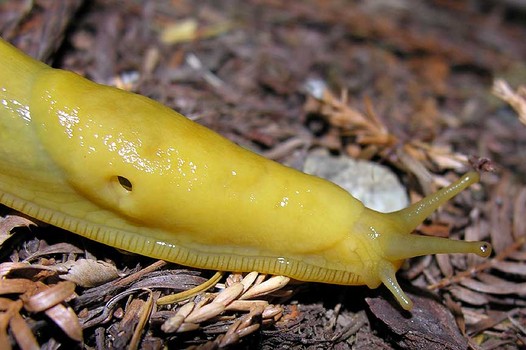The Banana Slug

Banana Slug inching
Banana Slug
Slithering along the path
No rushing here nor there
Chewing through molding leaf
Huge green and yellow composter…
The banana slug slimes its glistening path across the floor of the woods. Its bright yellow color and size surprise the eye in the shadows of the underbrush and the shade of the canopy. Okay, it is not always yellow; sometimes, it is brown, tan or even black. Tentative short tentacles or feelers atop its head sense the presence of objects through light and dark and help the slug to determine its direction. Compost and decay in the forest depend on the voracious appetite of this low, slithering creature. What astounds about the banana slug is the sheer size that it can attain. Their long cylindrical bodies can get up to the size of a large, mushy looking banana, yellow with brown spots. Scientists believe that their ability to hibernate through winter colds or dry summers allow them to attain their large size. Unlike ordinary slugs, they do not die off every year.
The banana slug moves in bare centimeters, taking its time. Like most slugs, it has only one muscular “foot”. As a consequence, moving about is not what it does readily. It prefers to hide in the dank, dark of a pile of leaves or old rocks. Through its eating, the banana slug recycles old leaf matter, spreading seeds and spores as it does so. It prefers mushrooms, but is also easily satisfied with lesser grub. The slime which allows it to move can also act as protection. Few animals enjoy touching the sticky ooze. The glue-like substance enables the banana slug to move in all kinds of directions and can give off a smell to attract a mate to its eggs. Not exactly, the most attractive creature in the woods, the banana slug and its less visible brown slug companions serve great usefulness by recycling and decomposing the debris along the forest floor. What child growing up in the Northwest woods doesn’t delight in its slick, gloppy perfection! Ugh and wonder!
“The real voyage of discovery begins not in seeking new landscapes but in having new eyes.” Marcel Proust
snohomish.wsu.edu/garden/Documents/FactSheets/92Slugs.pdf
Slithering along the path
No rushing here nor there
Chewing through molding leaf
Huge green and yellow composter…
The banana slug slimes its glistening path across the floor of the woods. Its bright yellow color and size surprise the eye in the shadows of the underbrush and the shade of the canopy. Okay, it is not always yellow; sometimes, it is brown, tan or even black. Tentative short tentacles or feelers atop its head sense the presence of objects through light and dark and help the slug to determine its direction. Compost and decay in the forest depend on the voracious appetite of this low, slithering creature. What astounds about the banana slug is the sheer size that it can attain. Their long cylindrical bodies can get up to the size of a large, mushy looking banana, yellow with brown spots. Scientists believe that their ability to hibernate through winter colds or dry summers allow them to attain their large size. Unlike ordinary slugs, they do not die off every year.
The banana slug moves in bare centimeters, taking its time. Like most slugs, it has only one muscular “foot”. As a consequence, moving about is not what it does readily. It prefers to hide in the dank, dark of a pile of leaves or old rocks. Through its eating, the banana slug recycles old leaf matter, spreading seeds and spores as it does so. It prefers mushrooms, but is also easily satisfied with lesser grub. The slime which allows it to move can also act as protection. Few animals enjoy touching the sticky ooze. The glue-like substance enables the banana slug to move in all kinds of directions and can give off a smell to attract a mate to its eggs. Not exactly, the most attractive creature in the woods, the banana slug and its less visible brown slug companions serve great usefulness by recycling and decomposing the debris along the forest floor. What child growing up in the Northwest woods doesn’t delight in its slick, gloppy perfection! Ugh and wonder!
“The real voyage of discovery begins not in seeking new landscapes but in having new eyes.” Marcel Proust
snohomish.wsu.edu/garden/Documents/FactSheets/92Slugs.pdf
